A Guide to Buying Industrial Coffee Grinders
Industrial vs. Commercial Grinders
People often mix up the words "industrial" and "commercial" when talking about coffee grinders. But they mean very different things. Buying the wrong type can be a big, expensive mistake for your coffee business.

A grinder's type depends on how it's used and how much coffee it can grind.
What Are Commercial Grinders?
A commercial coffee grinder is for on-the-spot use in places like a cafe, restaurant, or store. Its main job is to grind a small amount of coffee for one drink or bag at a time.
- How Much It Grinds: Performance is measured in pounds per minute or grams per second. A fast commercial grinder might handle one to three pounds a minute. But it's not built to run nonstop at that speed.
-
Common Uses: There are two main types of commercial grinding.
- Espresso Grinding: Dosing a small, exact amount for a single shot of espresso.
- Bulk Grinding: Grinding a bag of coffee for a customer to take home or for a single pot of drip coffee.
What Are Industrial Grinders?
An industrial coffee grinder is made to run all day long in a big production facility. You will usually find them in coffee roasteries.
- How Much It Grinds: Performance is measured in pounds per hour. These machines start at around 300 to 600 pounds per hour. Some can grind up to 20,000 pounds per hour.
- Common Uses: They grind huge amounts of roasted coffee that will be packaged and sold to other businesses. These are powerful machines that need special electrical setups. They are built to work hard without constant supervision.
For anyone buying equipment, knowing the difference between these grinders is the most important first step. The table below breaks it down with clear data.
Table 1: Grinder Class Comparison: Industrial vs. Commercial (Bulk & Espresso)
| Metric | Industrial Grinder | Commercial Bulk Grinder | Commercial Espresso Grinder |
|---|---|---|---|
| Primary Application | Roastery Production & Packaging | Retail Bagging & Batch Brew | On-Demand Espresso Dosing |
| Typical Throughput | 300 - 20,000 lbs/hr [2, 7] | 1 - 3 lbs/min [2, 10] | 2.5 - 7 g/sec [3, 11] |
| Common Burr Size/Type | 140mm+ Flat or Roller Mills [7, 12, 13] | 80mm - 98mm Flat [10, 14, 15] | 64mm - 85mm Flat [3, 11, 16] |
| Motor & Power | Three-Phase, 2.2kW - 8.2kW+ [8, 13] | 120V, ~9 Amps | 120V / 220V |
| Key Workflow Feature | Continuous Operation | Bag Switch / Timed Dosing | Grind-by-Weight (GbW) |
| Approx. New Price | $6,500 - $20,000+ [12, 20, 21] | $1,400 - $3,500 [22, 23] | $2,000 - $5,000+ |
How to Buy the Right Grinder
Industrial Grinders: Prices and Top Models
For a coffee roastery, buying an industrial grinder is a major investment. It is a core piece of equipment for the business. The market has a few key companies that specialize in these machines.

Here are some of the market leaders and their prices.
- Ditting: The KFA1403 model costs around $6,599. For bigger jobs, the DT 1827 model is about $15,999.
- Mahlkönig: The DK15 and DK27 are very popular in the industry. The DK15 is a good starting point for industrial grinding, with prices from $11,900 to $17,999.
- MPE (Modern Process Equipment): MPE makes grinders for extremely high volumes. Their models can handle from 1,000 to 4,000 pounds per hour. You have to contact them directly for pricing on these large systems.
- Other Brands: You can find other models like the ID-200, which is another option for high-volume grinding.
You might see the same model, like the Mahlkönig DK15, listed at very different prices. This is because these machines are configured for you, not just bought off a shelf. For example, a price difference of $6,000 could be just for an upgrade to stronger burrs made of tungsten carbide.
Buyers need to think about the total cost of ownership. The more expensive burrs last much longer and need less maintenance. This can save money over time and make the business more profitable.
Here are the main things that affect the price.
- Burr Material: Choosing between hardened steel and tungsten carbide is a major factor in the cost.
- Motor Power: These machines have powerful motors designed to run all day without getting too hot.
- Cooling Systems: Grinding all day creates a lot of heat, which can ruin the coffee. Industrial grinders have cooling systems to protect the beans.
- Grinding Speed: The price goes up with the output. A grinder that handles 4,000 pounds per hour is much more expensive than one that handles 500.
Why Commercial Grinders Cost So Much
For a new cafe owner, the price of a high-end commercial grinder, which can be over $5,000, might be a shock. This cost is for specific features that improve coffee quality and make the cafe run smoothly.
1. Burr Type, Size, and Shape: The Heart of the Grind
The burr set is the most important part of the grinder.
- Size: Commercial burrs are much larger than the ones in home grinders. A bigger surface area means the grinder can spin slower, which creates less heat and grinds faster.
-
Flat vs. Conical Burrs: This is the most important choice a buyer will make.
- Flat Burrs: These produce very uniform particle sizes. This is great for espresso and filter coffee because it creates a clear, bright flavor. The downside is they create more heat and can hold onto old coffee grounds.
- Conical Burrs: These produce consistent, but not perfectly uniform, particle sizes. They run cooler, waste less coffee, are quieter, and are often faster. They tend to create a cup with more body, which is good for traditional espresso.
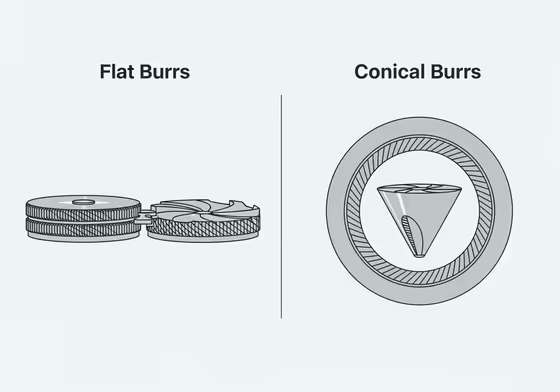
A pricey flat burr grinder is an investment in flavor clarity. A conical burr grinder is a good value for its speed and durability.
2. Motor Quality and Heat Management
A grinder in a busy cafe runs dozens of times an hour and gets very hot. In a cheap grinder, this heat makes the metal burrs expand, which changes the grind setting and ruins the coffee's consistency. A commercial grinder costs more because its motor is built to handle heat and stay stable shot after shot.
3. Workflow and Dosing Features
- Stepped vs. Stepless Adjustment: Stepped grinders have set "clicks" for grind size, which is fine for drip coffee. Stepless grinders allow for tiny adjustments, which is necessary for dialing in the perfect espresso shot.
- Dosing System: Basic grinders use a timer, but newer Grind-by-Weight (GbW) systems are more accurate. A GbW grinder uses a built-in scale to give the exact same amount of coffee every time. This provides amazing consistency.
4. Build Quality and Certification
The price also reflects a solid, all-metal build meant to last for years in a busy shop. Getting safety and food-grade certifications is expensive. Also, since many grinders are made in Europe, import fees add to the final cost.
Buying Used Grinders: Is It a Good Idea?
Buying a used grinder can be a great deal, but it can also be very risky. There are two main ways to buy used equipment.
The Two Paths to Buying Used:
- "Certified Refurbished": This is the safe way to buy used. You buy from companies that specialize in fixing up old equipment. These grinders are tested, guaranteed to work, and often come with a short warranty.
- "As-Is" / Private Sale: This is the risky path. You buy from places like eBay or from another person. The prices are much lower, but there is no guarantee the machine works well.
The Risk: The Real Value Is in the Burrs
A cheap price tag can be a trap. A used Bunn grinder for $150 seems like a great deal. But the part that wears out the most, the burrs, is also the most expensive to replace.
If a used grinder is slow or gets stuck, it probably needs new burrs. Replacement burrs for that "cheap" Bunn grinder can cost over $200. This is more than you paid for the grinder itself.
The "as-is" market is best for people who know how to fix machines and can test the grinder before buying it. For most business owners, paying more for a "certified refurbished" grinder is a smart way to avoid problems.
Good Used Grinders to Look For:
- Bunn Bulk Grinders: These are very common and parts are easy to find. You can often get one for $100 to $300, and it might run for years.
- Mazzer Super Jolly: This is a classic espresso grinder. It's a great choice for someone willing to learn how to use it, and it often sells for $200 to $300.
Checklist for Buying a Used Grinder
If you are looking at an "as-is" grinder, you have to inspect it in person. Here is a checklist to help you.
- Check its History: Ask the seller for service records. Where was it used before? A grinder from a small office is very different from one from a busy cafe.
- Look for Water Damage & Rust: Check for rust or white mineral buildup inside the machine. This is a sign of neglect and could mean there are bigger problems.
-
Test It Out: This is a must. Bring your own coffee beans to test it.
- Motor & Burr Health: Does it grind quickly? If it seems slow or struggles, you should assume it needs new burrs.
- Functionality: Test every single button, knob, and feature to make sure it all works.
- Check for Bad Repairs: Look for signs of sloppy work. Are all the screws the same? Mismatched screws could mean parts are stripped.
- Check for Parts: This is a big one. Contact the manufacturer to see if they still make parts for that model. Parts for an old Mazzer or Bunn are common, but an unknown brand could become a paperweight if one part fails.
Buying Wholesale Grinders
For businesses, "wholesale" just means buying directly from equipment suppliers instead of a retail store. These suppliers are the main source for new equipment with warranties.

But these business relationships are often more than just a single purchase. A supplier might bundle equipment with other services, like helping you find green coffee beans. So, the decision is often based on the total value the supplier offers, not just the price of one grinder.
Matching the Grinder to Your Needs
Large and Bulk Coffee Grinders
These are also called "shop grinders." They are the workhorses for cafes, grocery stores, and roasteries that need to grind a lot of coffee.
Where They Are Used:
- In a Cafe: It's used to grind large batches for drip coffee. It is also used to grind bags of coffee for customers to take home.
- In a Grocery Store: It's a self-service station for customers to grind the beans they just bought.
- In a Roastery: It's the "bagging" grinder used to fill orders for pre-ground coffee.
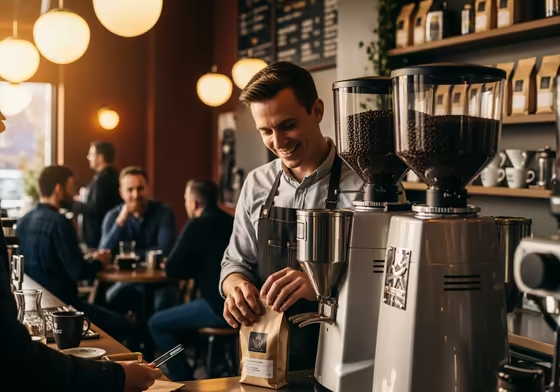
Understanding Capacity
It's important to know the difference between two types of "capacity."
- Hopper Capacity (How Much It Holds): This is simply how many pounds of whole beans the grinder can hold at once. This is a convenience feature. For example, the Bunn G1 holds 1 pound, the G2 holds 2 pounds, and the G3 holds 3 pounds.
- Throughput (How Fast It Grinds): This is the performance metric, measured in pounds per minute. The standard, set by Bunn, is grinding 1 pound of coffee in under 30 seconds.
This speed is what makes the grinder a good investment. In a busy cafe, grinding a bag of coffee for a customer by hand is slow and inefficient. A fast grinder lets the barista start the grind, help the next customer, and come back when it's done.
A Closer Look at Bunn Grinders
The Bunn bulk grinder is known as the "workhorse" of the industry. It is known for being durable, reliable, and a great value.
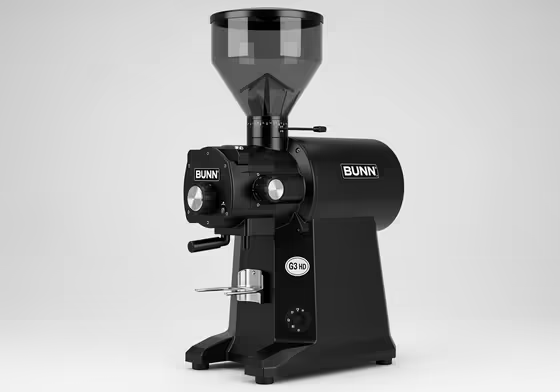
- The Models: The G-Series (G1, G2, G3) is the most popular. They are basically the same machine, just with different hopper sizes for 1, 2, or 3 pounds of beans.
-
Key Features & Reputation:
- Performance: Bunn grinders use a "turbo action" that pulls coffee through the grinding chamber for more speed.
- Workflow & Safety: The "Bag switch" is a great safety feature. It stops the motor when a bag is removed and won't let it start until a bag is in place.
- Maintenance: A built-in lever makes it easy to clean out all the old coffee grounds.
- Warranty & Durability: Bunn offers a four-year warranty on the grinding burrs, which shows how confident they are in their product.
The Best Grinders for Your Business
Best Bulk Grinders for Cafes
The Bunn G-Series is great for general use. But there is another class of "Specialty Bulk Grinders." For high-end cafes, the bulk grinder is a tool for creating specific flavors in their coffee.
This creates two different tiers of grinders. You have to decide if you need one for speed and bagging (Bunn) or for the best possible flavor in your drip coffee (Mahlkönig/Ditting).
Table 2: High-Volume Commercial Bulk Grinder Comparison
| Model | Burr Size/Type | Throughput (approx.) | Grind Adjustment | Approx. Price (New) | Best For... |
|---|---|---|---|---|---|
| Bunn G3 HD | 80mm Steel Conical [15] | ~2.0 lbs/min | Stepped | ~$1,400 [23] | Retail Bagging & Utility |
| Ditting 807 Filter | 80mm Special Steel Flat | ~1.0 lb/min (7.5 g/s) | Stepless | ~$2,700 | Specialty Batch Brew |
| Mahlkönig EK43 | 98mm Cast Steel Flat | ~2.6 lbs/min (20 g/s) | Stepless | ~$3,300 | Specialty Filter & Espresso |
The Specialty Standard: Mahlkönig EK43
- Reputation: The Mahlkönig EK43 is famous in the coffee world. It's known as the "king of grinders" and is very popular in high-end specialty cafes.
- Specs: It has huge 98mm cast steel flat burrs and grinds very quickly.
- Performance: Its reputation comes from its amazing grind consistency. This consistency allows baristas to brew coffee that has exceptional flavor clarity.
- Price: Approximately $3,299 to $3,399.
The Modern Option: Ditting 807 Lab Sweet
- Reputation: The Ditting 807 series is a newer grinder that has impressed a lot of people. It replaced the popular 804 series.
- Specs: It uses 80mm special steel flat burrs and has a good grinding speed.
- Key Feature: Its best feature is its cooling system. It has a second fan to keep the motor and burrs cool, which helps with consistency.
- Price: The Ditting 807 Filter model costs around $2,699.

Head-to-Head: Mahlkönig EK43 vs. Ditting 807 Lab Sweet
These grinders seem very similar. They are both legendary in the coffee world. They are even made by the same parent company.
But the choice between them isn't about which is better. It's about which flavor you prefer. The EK43 is known for creating a cup with high clarity. The 807 Lab Sweet has burrs designed to bring out more sweetness.
Best Espresso Grinders for Cafes
In a coffee shop, the grinder is even more important than the espresso machine. It's all about precision. The right features are essential for making consistent, great-tasting espresso.
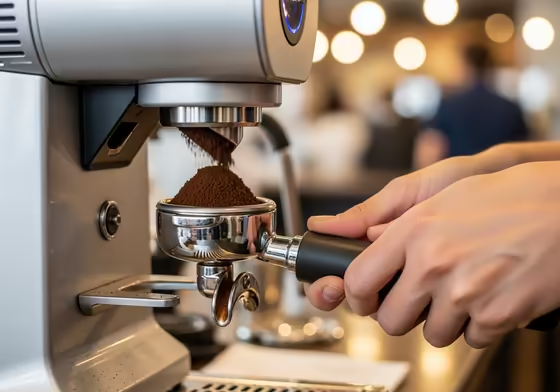
Key Features for Making Espresso
- Grind Consistency & Stepless Adjustment: This is the foundation of good espresso. Stepless adjustment is required to make the tiny changes needed to perfect a shot.
- Low Retention: Retention is the amount of old, stale coffee grounds left in the grinder. Low retention is very important for good flavor.
- Dosing Accuracy: Timed dosing is common, but Grind-by-Weight (GbW) is the best. GbW grinders dose by mass, ensuring every shot gets the exact same amount of coffee.
- Heat Management: A grinder gets hot during a morning rush. Heat changes the grind, forcing baristas to constantly adjust their settings. Good grinders have features like large burrs and cooling fans to prevent this.
- Workflow Features: Modern grinders also offer things like quieter operation and parts that are easy to clean. Some can even connect to the cloud to manage settings across multiple locations.
The top espresso grinders are not all the same. They represent different ideas about how a coffee shop should work.
- Idea 1: Ultimate Precision (Mahlkönig E80S): These grinders are for shops that focus on the absolute highest quality. They use weight-based dosing to give the barista total control.
- Idea 2: Barista-Driven Power (Mazzer Major V): This grinder is built for speed and durability, trusting the barista's skill. It's a powerful tool for a busy cafe.
- Idea 3: Staff-Proof Consistency (La Marzocco Swift): This grinder removes the human element. It automatically grinds, distributes, and tamps the coffee. This ensures every shot is identical, no matter who is making it.
The "best" grinder is the one that fits your cafe's business model.
Table 3: Flagship Commercial Espresso Grinder Comparison
| Model | Burr Size | Dosing System | Key Workflow Feature | Best For... |
|---|---|---|---|---|
| Mahlkönig E80S GbW | 80mm Flat | Gravimetric (GbW) | Grind-by-Weight dosing | Specialty-First Shops |
| Victoria Arduino Mythos 2 | 85mm Flat | Gravimetric (GbW) | Variable Speed Motor | WBC-Competitor Quality |
| Mazzer Major V | 83mm Flat [16] | Timed | Dual-Fan Cooling System | High-Volume Power |
| La Marzocco Swift | 64mm Flat | Volumetric / Auto-Tamp | Grinds, Distributes, & Tamps | Automated Consistency |
The High-Volume Titans: Mahlkönig E80S vs. Victoria Arduino Mythos 2
These are the top-of-the-line grinders for specialty coffee shops.
- Mahlkönig E80S GbW: Features 80mm steel burrs, grinds very fast, and is built around its famous Grind-by-Weight technology.
- Victoria Arduino Mythos 2: This grinder has 85mm burrs and uses both weight-based dosing and a variable-speed motor. It is the official grinder of the World Barista Championship.
- The Decision: Both are excellent. The Mythos 2 has slightly larger burrs and more motor control. The E80S is the long-standing choice for reliable weight-based grinding.
The Workhorse Standard: Mazzer Major V vs. La Marzocco Swift
This comparison is about how you want your cafe to run.
- Mazzer Major V: This is an updated version of a classic cafe grinder. It uses huge 83mm flat burrs and a dual-fan cooling system. It's built for speed and durability, giving a skilled barista a powerful tool.
- La Marzocco Swift: This grinder is a complete workflow solution. It automatically grinds, distributes, and tamps the coffee with perfect consistency every single time.
- The Decision: The Mazzer is for a shop that trusts its baristas' skills. The Swift is for a business, like a hotel or restaurant, that needs to eliminate human error and ensure every shot is perfect.
A Look at Popular Grinder Brands
Curtis Grinders
- Brand Position: Wilbur Curtis is mainly a coffee brewer company. Its grinders are designed to be part of a complete Curtis brewing system.
- Models: The lineup includes models designed to work seamlessly with their brewers.
- The "Ecosystem" Idea: Curtis grinders have features that only make sense when used with a Curtis brewer. They are built to lock into place with the brewer and grind the perfect amount of coffee automatically.
- Conclusion: People buy a Curtis grinder because they are buying a Curtis brewer. The system is designed for easy, automated batch brewing. It prioritizes convenience over the standalone grind quality of a specialty brand.
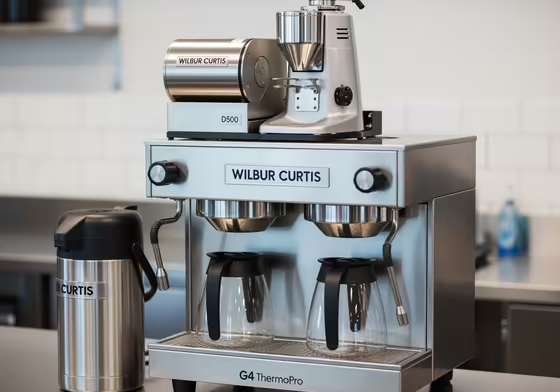
Eureka Grinders
- Brand Position: Eureka is an Italian company known for its precise engineering. They are especially famous for their "Silent Grind Technology."
-
Model Comparison: Atom vs. Olympus Series
- The "Quiet vs. Power" Choice: The Eureka Atom 75 and Olympus 75 both use the same 75mm flat burrs. The difference is the environment they are designed for.
- The Atom 75 is known for being very quiet. It's made for home users or small cafes where loud noise would be a problem.
- The Olympus 75 is built for raw power and is not quiet. It can handle a lot of grinding and is made for the morning rush in a busy coffee shop.
- Conclusion: Eureka split their 75mm platform into two grinders. The Atom is for places where low noise is important. The Olympus is for places where speed is the only thing that matters.

Bunn Grinders
- Brand Position: Bunn is the classic "workhorse." The brand is known for being extremely durable, reliable, and a good value.
-
Performance vs. Price: Bunn G-Series vs. Mahlkönig EK43
- The Basic Difference: The simple view is that Bunn is for utility while the EK43 is for quality. The price reflects this, with the Bunn costing much less.
- The Deeper Story: It gets more interesting when you look closer. Some tests show that the Bunn grinders can actually produce a more uniform grind than the EK443.
- But even so, many coffee experts prefer the more complex flavor that comes from the EK43's grind.
- Conclusion: The EK43 is famous for its specific grind, which includes some fine particles. These fines are seen as a feature, not a flaw. They help create the complex flavors that define modern specialty coffee.
- Final Verdict: The Bunn G-Series is the better utility grinder for speed and durability. The EK43 is the better specialty grinder for creating a specific, high-end flavor profile.
Used Mazzer Grinders
- Brand Position: Mazzer grinders have been a top choice in cafes for decades. They are popular both new and used because they are built like tanks and parts are easy to find.
-
Used Buyer's Guide: Mazzer Super Jolly vs. Major
- The Core Difference: Speed and Power.
- Super Jolly: This is the classic starter model. It uses 64mm flat burrs and is a reliable, though slower, grinder.
- Major: This grinder is a monster. It uses massive 83mm flat burrs, is much faster, and is built for very high volume.
- The Home User Trap: The low price of used Mazzers makes them popular with advanced home users. But these users often want to "single dose," meaning they only grind enough for one shot at a time.
- This is a big problem. Mazzers are not built to single dose. They hold onto a lot of old grounds and are meant to be used nonstop in a busy cafe.
- Conclusion: A home user buying a used Mazzer needs to know this. The good deal is only worth it if they are okay with wasting a few grams of coffee before each shot. Otherwise, they will need to buy special parts to make it work well for home use.